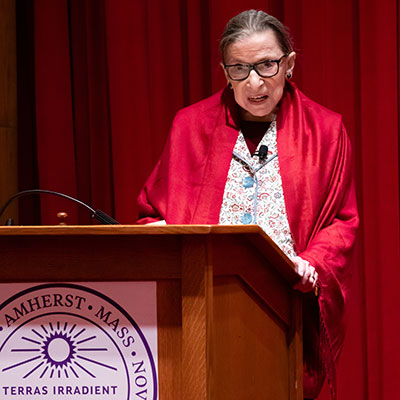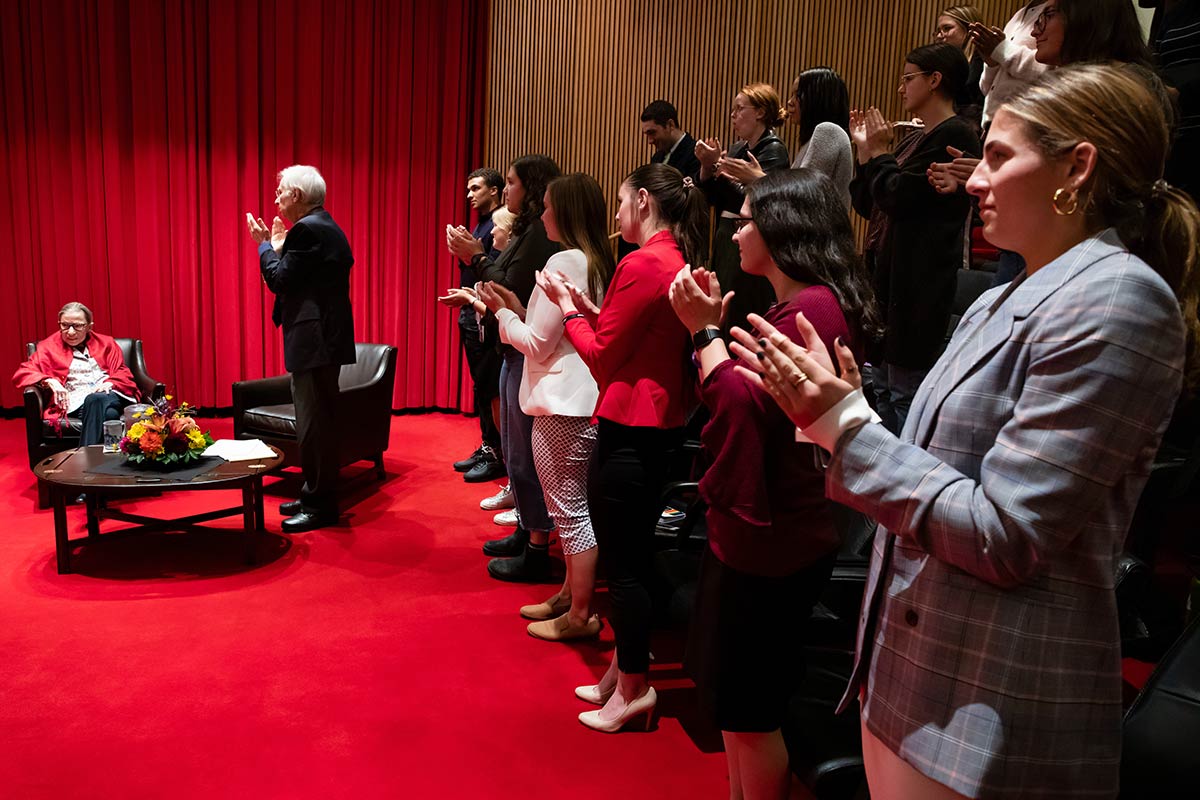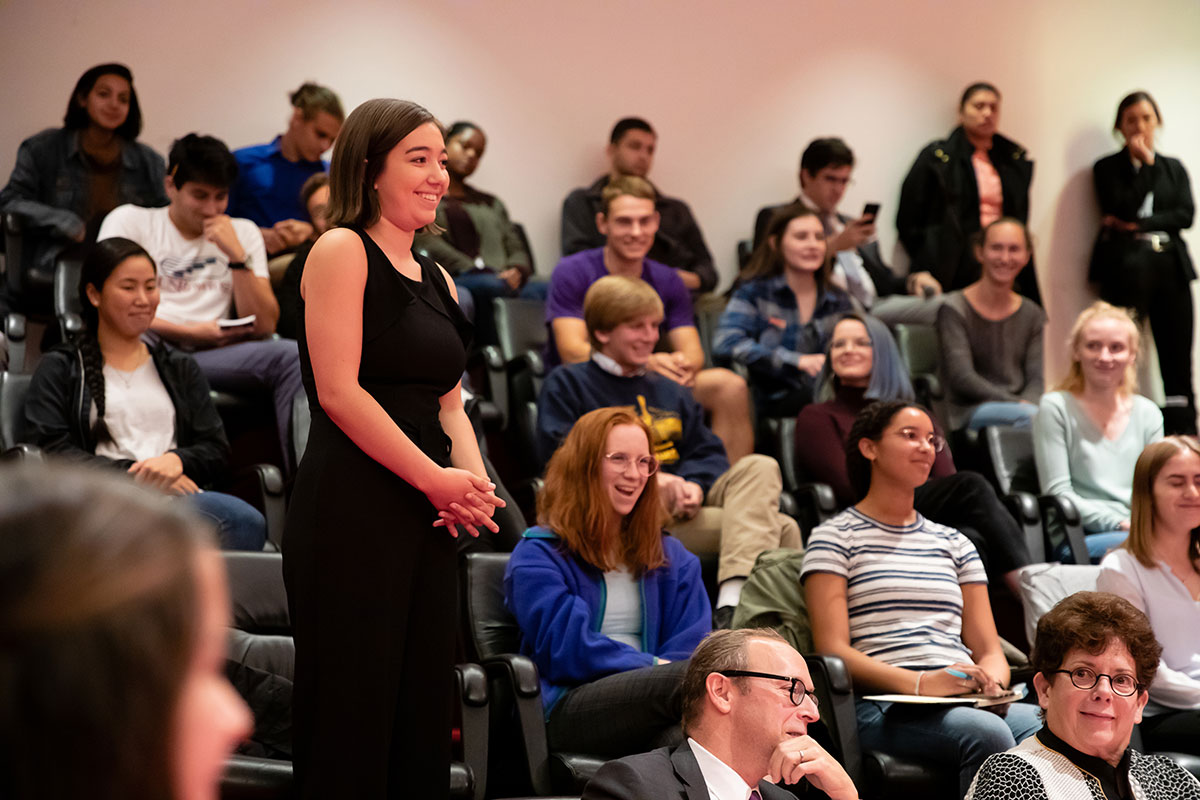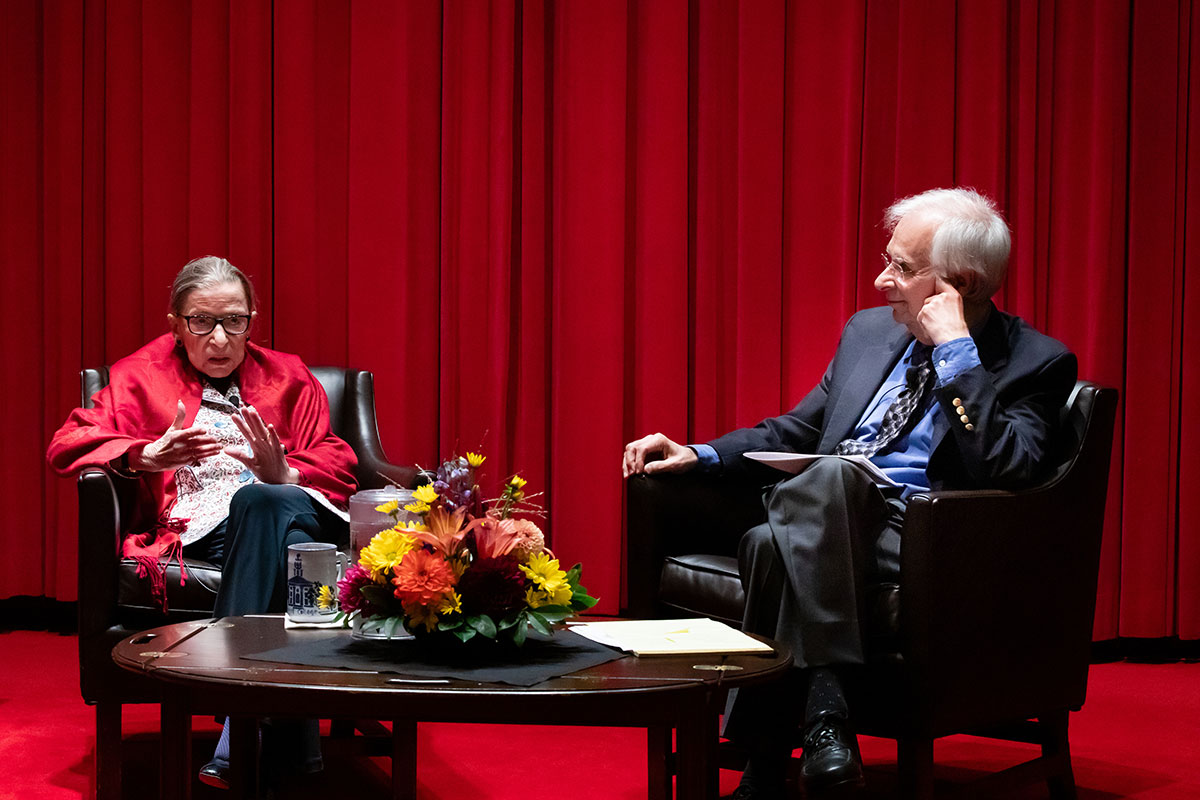
Professor Austin Sarat, the William Nelson Cromwell Professor of Jurisprudence and Political Science, acted as host, relaying pre-written questions from some of the students in the room.
Justice Ginsburg began by standing at the dais in Cole Assembly Room, her coral-colored shawl set off by the room’s cherry red carpet and bright lights, and gave her overview of the preceding Supreme Court term. She read from her text, speaking quietly and deliberately, with occasional flashes of humor.
That term kicked off with just eight justices, because of the retirement of Justice Anthony Kennedy. She ranked his retirement “as the event of greatest consequence not only to the last term, but to many terms ahead.”
From there, she highlighted the term’s statistics. Justice Stephen Breyer spoke the most words during oral arguments, she reported, and Justice Sonia Sotomayor asked the most questions. “Justice Clarence Thomas, who ordinarily asks no questions, because he thinks the rest of us ask too many,” broke his silence for the first time since 2016, she said, asking three during the term.

The highest agreement rate in decisions was between Justice Sotomayor and herself, she added, though close behind was Chief Justice John Roberts paired with Justice Kennedy’s replacement, Justice Brett Kavanaugh. “The highest disagreement rate is Justice Sotomayor, again paired with me on one side, and Justice Thomas on the other,” she added.
“Shortest time between oral argument and opinion release—I rank first,” she said.
Justice Ginsburg also cued the role of women: “Justice Kavanaugh made history last term by bringing on board an all-female law clerk crew.” At the Supreme Court, there were, “for the first time ever, more women than men serving as law clerks,” she added. “Women did not fare nearly as well as advocates. Only about 21 percent of the attorneys presenting arguments last term were women.”
Next, she debunked the idea that the Supreme Court is a hotbed of contention. Of the 6,000-plus petitions brought up for review in the last term, the court issued 68 opinions. Of that 68 only 20 were 5-4 (or 5-3) rulings, with 26 decided unanimously.
Said Justice Ginsburg: “The takeaway: we agree considerably more often than we sharply divide.”
Then she gave sketches of a half dozen notable cases from the term, which covered such topics as gerrymandering, citizenship and gun possession.
“One of the most momentous,” she said, was Department of Commerce v. New York, wherein the Supreme Court decided against including a citizenship question on the 2020 census. The reason to include, as framed by U.S. Secretary of Commerce Wilbur Ross (the census falls under Commerce’s jurisdiction) “appears to be contrived,” Justice Roberts wrote for the majority, which included Justice Ginsburg. Today, she said Ross’s stated reason was “to put it bluntly, disingenuous.”
Justice Ginsburg also commented on her dissenting opinion in American Legion v. American Humanist Association. It concerned a 40-foot-tall Latin “Peace Cross,” built on private property in 1925 in Maryland as a memorial to local soldiers who had died in World War I. Later, the property was sold to the state, and thus the cross now lay on government land, possibly violating the separation of church and state. The majority ruled that the longstanding monument was not strictly a religious symbol, as the cross was a symbol of peace in the era, and let the cross stay.
Justice Ginsburg disagreed: “I wrote that the towering cross was scarcely secular in character. It is emblematic of Christianity, and of no other faith. Maintenance of the cross on public land made it appear that the state-endorsed Christianity, and relegated adherence to other religions to outsider status.”

There were light moments to the event. Before Justice Ginsburg arrived late, due to a flight delay, Sarat warmed up the crowd by asking who could name the justices in alphabetical order—by first name. And, at one point, Justice Ginsburg shared that she was especially happy when Justice Elena Kagan, then junior-most justice and thus liaison to the staff cafeteria, finagled a Supreme Court frozen yogurt machine.
Justice Ginsburg also answered a question about what artworks hang in her office, from Matthew Ezersky ’22. Two Rothkos, a Josef Albers and a Max Weber, some on loan from the National Gallery, Justice Ginsburg answered. Sarat joked: “You’ve given a reason for Matthew to aspire to the Supreme Court.” Justice Ginsburg volleyed back: “It’s a really nice perk, isn’t it?”
She gave sobering answers to other student questions. Sarat read her a question from Camille Polk ’21: “What is the most difficult decision you had to make while on the Supreme Court, and why is it the most difficult?”
Justice Ginsburg responded not by listing a particular decision, but rather a type of case, specifically anything to do with the death penalty. “If I were queen, there would be no death penalty,” she said to applause and an affirmative grin from Sarat, a scholar on the death penalty (whose books were once cited on the same day, in the same case, by two different justices).
“The first time I faced one of those [cases], I was very distressed,” Justice Ginsburg said, shaking her head at the memory of 11th-hour requests for stays of execution. “Now, I might have taken the position that justices [William] Brennan and [Thurgood] Marshall took. They said [the death penalty] was unconstitutional in all circumstances. If I did that, I would take myself out of the running in death penalty cases. I would not have the possibility of making the law a little better than it is. So, I have chosen to participate in those cases.”
Sarat also delivered a question from Alison Weiss ’23: “When you are in the minority in a decision, do you feel that the court made a mistake? Or is the decision of the court right, insofar as the court is the final arbiter of the constitution?”

“Whenever I speak in dissent, I am persuaded that the court got it wrong,” Justice Ginsburg answered, lamenting that most courts around the world do not allow dissenting opinions. “That’s why we write dissenting opinions, so that the public will see that there is more than one side. The United States is special in that regard. If we reveal our division, we might convey to the public that the law is unstable.”
Skyler Sung ’23 had a question about how the justice calls on sympathy when she confers with other judges, as with the 2008 decision Safford Unified School District v. Redding. In that case, a 13-year-old girl who had pills in her possession (they turned out to be ibuprofen) had been strip-searched in the girl’s bathroom at the school: the girl’s mother sued the school district. The case came before the Supreme Court during the three-year period when Justice Ginsburg was the lone female justice, after Justice Sandra Day O’Connor retired and Justice Sotomayor joined the bench.
“In the argument before the court, the other justices compared the girl’s situation to boys undressing in the locker room before gym classes, which was, according to one of my colleagues, ‘no big deal,’” said Justice Ginsburg. “That’s when I stopped that line of questioning. I said a 13-year-old girl is not the same as a 13-year-old boy. She is very vulnerable at that time in her life, very conscious of changes in her body, humiliated by being forced to undress and be strip-searched. My effort was to get my colleagues to think about people they knew and cared for. Instead of joking about the boys in the locker room, think of how they would like their daughters and granddaughters to be treated.”
Asked Sarat: “Did it work?”
The woman who has arguably done more for women’s rights than any lawyer or judge in U.S. history, and whose 27th Supreme Court term started on Monday, smiled broadly.
“Oh yes,” Justice Ginsburg said. “She won big.”